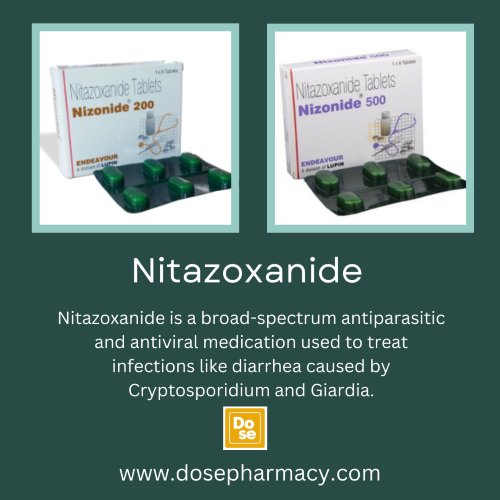What Parasites Does Nitazoxanide Treat?
Nitazoxanide treats a variety of parasites, including Giardia, Cryptosporidium, and helminths, offering effective relief from intestinal and systemic infections.

Nitazoxanide 500 mg is an antiparasitic and antiviral medication widely recognized for its effectiveness in treating various parasitic infections. Developed initially to combat intestinal infections, it has gained popularity for its broad-spectrum activity and minimal side effects. This article delves into the parasites that nitazoxanide targets, how it works, and why it’s an important option for treating parasitic diseases.
How Nitazoxanide Works
Nitazoxanide 200 mg works by interfering with the energy metabolism of parasites. Specifically, it inhibits pyruvate:ferredoxin oxidoreductase (PFOR), an enzyme essential for the energy production of many parasites. By disrupting this process, nitazoxanide prevents the parasites from surviving and replicating, ultimately leading to their eradication from the host's body.
Its broad activity also extends to bacteria and viruses, but its primary use is in treating intestinal parasites. Nitazoxanide is available in tablet and liquid form, making it suitable for both adults and children.
Parasites Treated by Nitazoxanide
Here are the primary parasitic infections that nitazoxanide is commonly prescribed for:
1. Giardia lamblia (Giardiasis)
Giardiasis, caused by the protozoan Giardia lamblia, is a common intestinal infection worldwide. It spreads through contaminated food, water, or direct contact with an infected person. Symptoms include diarrhea, abdominal cramps, bloating, and fatigue. Nitazoxanide effectively clears the infection by targeting the parasite’s metabolism, making it a top choice for treatment, especially in children.
2. Cryptosporidium (Cryptosporidiosis)
Cryptosporidiosis is caused by Cryptosporidium, a microscopic parasite that leads to severe watery diarrhea. It is particularly dangerous for individuals with weakened immune systems, such as those with HIV/AIDS. Nitazoxanide is the only FDA-approved treatment for cryptosporidiosis, proving to be highly effective in reducing symptoms and eliminating the parasite.
3. Entamoeba histolytica (Amoebiasis)
Entamoeba histolytica causes amoebiasis, which affects the large intestine and sometimes the liver. Symptoms include abdominal pain, bloody diarrhea, and fever. Nitazoxanide offers an effective alternative to traditional treatments, especially for mild to moderate infections.
4. Helminths (Worms)
Nitazoxanide also demonstrates activity against certain helminths, or parasitic worms, such as:
- Fasciola hepatica (Liver Fluke): Nitazoxanide has shown effectiveness in treating infections caused by liver flukes, which can lead to liver damage and bile duct issues.
- Ascaris lumbricoides (Roundworm): Though not the primary treatment for roundworm infections, nitazoxanide has been used successfully in some cases.
5. Blastocystis hominis
Blastocystis hominis is a protozoan found in the gastrointestinal tract, often linked to irritable bowel symptoms like diarrhea, bloating, and abdominal pain. Nitazoxanide has been shown to reduce the parasite load and alleviate symptoms in infected individuals.
6. Cyclospora cayetanensis (Cyclosporiasis)
Cyclospora cayetanensis causes cyclosporiasis, an intestinal infection characterized by watery diarrhea, cramping, and fatigue. This parasite is commonly associated with contaminated produce. Nitazoxanide is one of the most effective treatments for cyclosporiasis, helping to clear the infection quickly.
Other Potential Uses of Nitazoxanide
Beyond the common parasites mentioned above, nitazoxanide is being studied for its efficacy against other infections, including:
- Toxoplasma gondii (Toxoplasmosis): Research suggests that nitazoxanide may have some activity against toxoplasmosis, a serious infection caused by Toxoplasma gondii.
- Microsporidia: Emerging studies show promise in using nitazoxanide to treat microsporidiosis, a parasitic infection seen in immunocompromised individuals.
Its antiviral properties have also drawn attention, especially in treating conditions like rotavirus and influenza.
Who Can Use Nitazoxanide?
Nitazoxanide is approved for use in both adults and children above the age of 1 year. Its liquid formulation is particularly helpful for young children, who may struggle with swallowing tablets. It is considered safe, with mild side effects such as nausea, headache, or abdominal pain.
However, it is important to consult a healthcare professional before taking nitazoxanide, as the dosage and duration depend on the type and severity of the infection.
Advantages of Nitazoxanide
- Broad-Spectrum Activity: Nitazoxanide is effective against a wide range of parasites, making it a versatile treatment option.
- Minimal Resistance: Unlike some antiparasitic drugs, nitazoxanide has a low likelihood of resistance, ensuring its effectiveness in various scenarios.
- Well-Tolerated: Side effects are typically mild and temporary.
Precautions and Considerations
- Pregnancy and Breastfeeding: Nitazoxanide should be used with caution during pregnancy or breastfeeding. Always consult a doctor before starting treatment.
- Drug Interactions: Inform your doctor about any medications you are taking, as nitazoxanide may interact with other drugs.
Nitazoxanide is a powerful and versatile medication for treating a wide range of parasitic infections, including giardiasis, cryptosporidiosis, amoebiasis, and certain helminth infections. Its unique mode of action, combined with minimal side effects, makes it a go-to choice for both children and adults.
If you suspect a parasitic infection or have symptoms such as persistent diarrhea or abdominal discomfort, consult your healthcare provider. With the proper use of nitazoxanide, you can effectively eliminate parasites and regain your health.
What's Your Reaction?



















